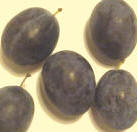Prunes
Information about Prunes plus Prune recipes
collection
Â
Â
Â
 Firstly,
what exactly is a Prune? Firstly,
what exactly is a Prune?
Â
basically they are fully ripened plums which have
been dried to remove most of the water. But not all plums are suitable to be
dried into prunes. The most common variety of plum used for prunes is d'Agen. At
maturity, they have a deep purple skin and they have a higher acid content and
more sugar which makes it possible for the fruits to be dried with their stones
intact without fermenting.
Â
Ounce for ounce, prunes contain more fibre than dried beans and
most other fruits and vegetables and more than half of the fibre is of the
soluble type which studies have linked to lowered blood-cholesterol levels. They
are also a good source of B vitamins and potassium. They contain the
same vitamins, minerals and fibre as their fresh counterparts i.e. plums.
Â
Origins
and History of Prunes
Â
In order to talk about prunes, we must touch briefly the raw
article i.e. plums Prunus Domestica. This strain of plums is known to have
existed since ancient times, and is believed to have originated in Western Asia.
Certainly both plums and prunes were well known to the ancient Egyptians as
findings in tombs at Thebes proved and a Sumerian clay tablet (2150 BC)
describes poultices being made from a concoction of ingredients which included
prunes. However it wasn�t until the 12th century, when Crusaders brought damson
trees over to Europe from Syria, that prunes began to make their mark in the
west.
As mentioned above, not all plums are suitable to produce prunes and it was the
monks in the Abbey of Clairac in south-west France, who crossed a damson tree
with a local plum, thereby creating a new variety called the Ente Plum which
could be preserved for a whole year once they had been dried in the sun. By the
early 16th century, plum orchards were flourishing throughout the region and a
while after the port of Agen gave its name to the dried fruit of the Ente plum -
the famous D�Agen prune.
Â
Â
Production of Prunes
Â
 As
one would expect, originally Prunes were sun-dried much like raisins, however
now they are mainly machine air-dried to obtain a more uniform product. The
fruit are allowed to fully ripen on the tree and immediately after they are
picked they are washed and dehydrated until the moisture content has been
reduced to approximately 21% as this produces the optimum keeping properties. As
one would expect, originally Prunes were sun-dried much like raisins, however
now they are mainly machine air-dried to obtain a more uniform product. The
fruit are allowed to fully ripen on the tree and immediately after they are
picked they are washed and dehydrated until the moisture content has been
reduced to approximately 21% as this produces the optimum keeping properties.
They are then graded for size, inspected and put into storage to await final
processing and packaging. Unlike other processed fruits, most prunes are not
packaged straight away but are stored in what is known as �natural condition�
until an order comes in, at which point they are sometimes partially re-hydrated
and packaged.
Â
Â
Cooking with Prunes
Â
Prunes can be used in sweet and savoury dishes much the same way
figs or dates are used. After opening the package, reseal it as tightly as
possible or transfer the prunes to an airtight container. Store them in a cool,
dry place or in the refrigerator for up to six months.
Reconstituting prunes: How to reconstitute Prunes
Â
As mentioned above, some prunes you buy in hermetically sealed packets are
partially re-hydrated which produces a much softer prune than if you were to buy
them fully dried. You can usually eat these straight from the packet and they
don�t need reconstituting before use. The instructions below are for prunes
which are still in their fully dried state.
To plump prunes � place the fruit with an equal amount of liquid in a small
saucepan and simmer for 7 to 10 minutes. Do not boil as the skins may split.
To plump prunes overnight - place the prunes in a heatproof bowl , add enough
boiling liquid to cover then cover the bowl and leave for about 8 hours.
To soften prunes in the microwave - sprinkle them with liquid, cover, and cook
at 100% power for about 2 minutes.
Â
Â
CLICK HERE FOR LOTS OF
RECIPES USING PRUNES
|